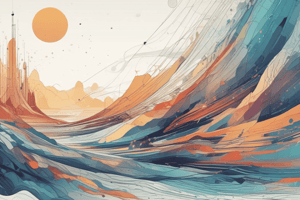Podcast
Questions and Answers
What is the difference between discrete data and continuous data?
What is the difference between discrete data and continuous data?
- Discrete data can be measured, while continuous data can be counted.
- Discrete data is countable and finite, while continuous data is uncountable and infinite. (correct)
- Discrete data has infinite possible values, while continuous data has finite values.
- Discrete data has a straight line graph, while continuous data has a curved graph.
What does the slope of a distance vs. time graph indicate?
What does the slope of a distance vs. time graph indicate?
- The mass of the object
- The speed of the object (correct)
- The distance the object has traveled
- The acceleration of the object
How can you convert kilometers to meters?
How can you convert kilometers to meters?
- Divide by 1000
- Multiply by 3600
- Divide by 3600
- Multiply by 1000 (correct)
What is the difference between speed and velocity?
What is the difference between speed and velocity?
According to Newton's second law of motion, what is the relationship between force, mass, and acceleration?
According to Newton's second law of motion, what is the relationship between force, mass, and acceleration?
In terms of forces, what does it mean when forces are balanced?
In terms of forces, what does it mean when forces are balanced?
What quantity does a force vector represent?
What quantity does a force vector represent?
What happens when an object undergoes negative acceleration?
What happens when an object undergoes negative acceleration?
What does Newton's first law of motion state?
What does Newton's first law of motion state?
Flashcards
Discrete Data
Discrete Data
Data that is countable and finite.
Continuous Data
Continuous Data
Data that is uncountable and infinite.
Slope of Distance-Time Graph
Slope of Distance-Time Graph
Indicates the speed of an object.
Speed vs. Velocity
Speed vs. Velocity
Signup and view all the flashcards
Newton's Second Law of Motion
Newton's Second Law of Motion
Signup and view all the flashcards
Balanced Forces
Balanced Forces
Signup and view all the flashcards
Force Vector
Force Vector
Signup and view all the flashcards
Negative Acceleration
Negative Acceleration
Signup and view all the flashcards
Newton's First Law of Motion
Newton's First Law of Motion
Signup and view all the flashcards
Study Notes
Data Types
- Discrete data: finite values that can be counted
- Continuous data: infinite possible values that can be measured
Distance-Time Graphs
- Distance: usually measured in meters
- Time: usually measured in seconds
- Slope: represents speed (rate of change of distance)
- Straight line on a distance-time graph indicates constant speed
Speed and Velocity
- Speed: magnitude of movement (distance divided by time)
- Velocity: magnitude and direction of movement
- Acceleration: rate of change of velocity (can be positive or negative)
Unit Conversions
- 1 kilometer (km) = 1000 meters (m)
- To convert meters to kilometers, divide by 1000
- To convert kilometers to meters, multiply by 1000
- 1 centimeter (cm) = 0.01 meters (m)
- To convert meters to centimeters, multiply by 100
- To convert centimeters to meters, divide by 100
Acceleration
- Acceleration: rate of change of velocity (includes time and final velocity minus initial velocity divided by time)
- Object accelerates when forces are unbalanced
- Object has constant speed or is motionless when forces are balanced
Laws of Motion
Law 1: Inertia
- Objects in motion or at rest remain in that state unless an unbalanced force acts upon them
- Without gravity, objects would not change their motion
Law 2: Force, Mass, and Acceleration
- Force (measured in Newtons): mass multiplied by acceleration (F = ma)
- Mass: amount of matter in an object
- Objects with more mass move slower, while objects with less mass move faster
Law 3: Action and Reaction
- For every action (force) in nature, there is an equal and opposite reaction
Forces
- Force: push or pull that can cause a change in direction, size, shape, motion, and speed
- Measured in Newtons (N)
- Force has magnitude and direction (vector)
- Balanced force: net force is zero, no change in motion
- Unbalanced force: net force is not zero, causes change in motion
Studying That Suits You
Use AI to generate personalized quizzes and flashcards to suit your learning preferences.




